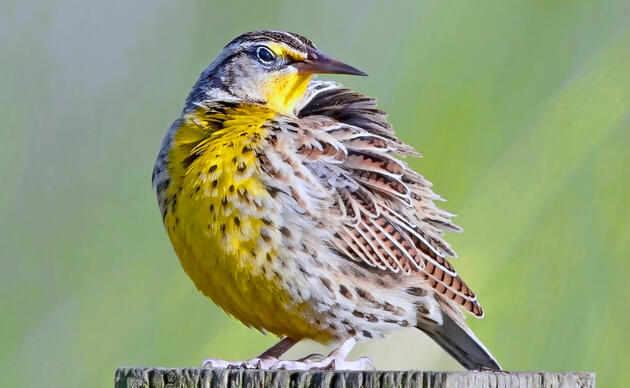The results are in for who traveled the furthest to attend the 2022 Fargo Birding Festival at Forest River Park. That title goes to the Bobolink! Although Bobolinks weigh the same as a golf ball, they make an incredible 4,500 mile journey from South America to nest right here in North Dakota each summer. The birds we saw flew over the Amazon Rainforest and Gulf of Mexico on their arduous migration and made it to Fargo just in time for us to greet them!
More than 150 people woke up early on a Saturday morning to experience the spring migration, making this year’s festival the largest in its decade-long history. Attendees, guided by local bird experts including myself, identified 70 species of birds. This was my first year as a guide for the Fargo Birding Festival and it was a joy to share my love of birds with others! The green forest, speckled with the yellow of Cape May Warblers, the red of Northern Cardinals, and the blue of Eastern Bluebirds, made for a welcome splash of color after a long and brutal winter. Bird guides taught attendees how to identify birds by sight, by sound, and by behavior. We observed the peculiar tail-wagging of Palm Warblers and the ever-ubiquitous male American Redstarts which fan their stunning black and orange tails to attract mates and claim their territory. We listened closely to secretive Gray Catbirds in the underbrush who mimic dozens of bird calls in their complex songs that at times sound cat-like. We even caught glimpses of Ruby-throated Hummingbirds whose metabolism is so fast that if they were the size of a human, they would need to eat the equivalent of 300 hamburgers a day to survive! These birds fascinated a seven-year-old bird enthusiast who exclaimed “wow!” every time I pointed out a new species – a spitting image of me at that age.
My interest in birdwatching started when I was seven and my neighbor gave me his leatherbound Audubon guide to the birds of eastern North America. Birdwatching is accessible to people of all ages and skill levels because birds are everywhere, and it doesn’t take much to get started. All it took for me was a bird field guide, a cheap set of binoculars, and the birds in my backyard. Birdwatching is also easily approachable because it can adapt to your interests. Some people watch birds because they love photography and find birds to be beautiful and often challenging subjects. Others simply love to watch birds at their feeders and find joy in the constant activity outside their windows. Some birders, myself included, love the thrill of the chase and enjoy searching for birds in competition with others. Whatever you like – whether it be painting, writing stories, hiking, or socializing with others – birds can be a part of your hobbies and everyday life. The 150 festival attendees all had their own personal story of why they were there and what fascinated them about birds. One attendee loved to photograph birds and shared his photos with other people in the group. Another watched birds in her backyard and wanted to socialize with others who shared her interest.
Whatever draws you to watching birds, one thing is certain – bird populations are declining at a concerning pace. Since the 1970s, North America’s bird population has declined by a staggering 30% due to various factors including predation by stray cats, loss of habitat, collisions with building windows, pollution, and over-application of pesticides to name just a few. Thanks to Audubon Dakota and your contributions to its mission, places like Forest River are protected for future generations of birds that need habitat to find food, take cover, and raise their young.
When I am not leading bird tours at Forest River Park, you might see me there researching birds for NDSU. I am a master’s student in the School of Natural Resource Sciences and I am working to understand what birds migrate through and nest in Fargo-Moorhead along the Red River. Next summer as you visit parks along the river you may also encounter kiosks with surveys asking people about their activities in the parks. Please take time to fill out these surveys as they will provide important information for my research to guide the future of our urban parks. Your answers will help us to design new educational materials and events and to show the importance of birdwatching for our community and economy.
Just like the Bobolinks, we hope you return next year for another great birding festival!
Tucker Lutter











